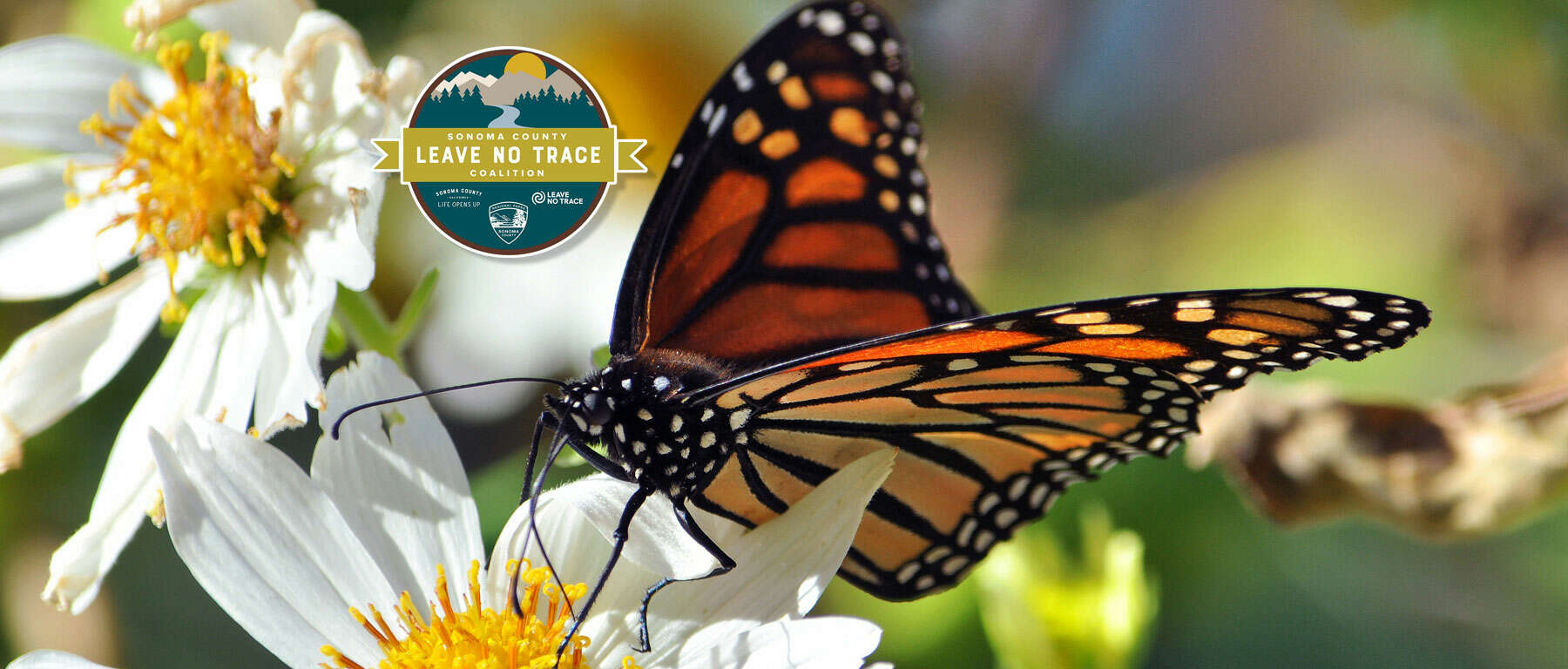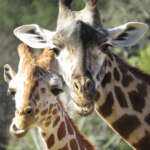The Beauty of Sonoma County is Priceless
Posted in: Conservation
Tags: Leave No Trace, Sonoma County
Experiencing our destination through the Sonoma County Leave No Trace Seven Principles gives travelers an opportunity to make a difference. Together, we can protect and preserve this special corner of the world for generations to come.
Know Before You Go
Sonoma County’s beautiful and varied terrain beckons travelers to hike through towering redwood forests, paddle along meandering rivers, or simply unwind to the sounds of nature. With so many things to see and do, it’s best to take some time to plan ahead. When you’re prepared for your adventure, you and your group are more likely to have a good time and help protect the outdoors.
- Learn about the areas you plan to visit. Go online to regularly check the conditions ahead of time, as they may change frequently due to weather, temperature swings and drought.
- Be prepared for crowded parking lots, trails and potential closures. Parking lots at some of our more popular parks and trailheads can fill early on weekends and holidays. Plan to arrive early in the morning or later in the day for the best chance of finding parking.
- Avoid parking in residential neighborhoods. If a parking lot is full, have a “Plan B” destination in mind.
- River and ocean safety is key. While in the water, always wear a life jacket and do not push yourself past your experience level. Before heading to the river, go online to check river conditions and water temperatures. If visiting the coast, check ocean-use policies and learn about riptides and sleeper waves.
- Bringing your dog along? Keep your canines leashed when enjoying dog-friendly destinations, bring your furry friend some extra water, and a plastic bag to pack out their waste (all the way to a trash can).
- Red flag warnings and campfire restrictions may be in place. Warm temperatures, low and strong winds combine to create dangerous wildfire conditions. When campfires are prohibited, have alternative methods for staying warm, cooking food and enjoying your time that does not involve campfires.
Stick to Trails and Be a Water Wise Camper
While shortcuts may be tempting, please don’t take (or create) them. Some seemingly small actions can have unintended consequences. Respect private property and stay on designated trails. Your shortcut may be a neighbor’s backyard or important wildlife habitat. Other small actions — like conserving water — can make a big difference. When we minimize human impact in our outdoor spaces, we help keep them pristine, beautiful and healthy for all.
- Walk, ride and photograph on designated trails. Designated trails are intentionally built and help to prevent erosion and protect vegetation from being trampled. Once damaged, vegetation may not grow back.
- Stay back from the bluffs. Be careful when taking photos near coastal cliffs. While the backdrop can be enticing, the rocks and shale formations are unstable. Stay on designated trails and heed warning signs.
- Be water-wise this camping season. Northern California is experiencing a drought and water restrictions are in place at some campgrounds. Check restrictions and recommendations ahead of time.
- Camp prepared! Weather is variable in Sonoma County, often with cool mornings and sunny, hot afternoons. Camp in layers for comfort. It’s also important to stay hydrated. Bring along a reusable water bottle to stay hydrated and limit waste.
Trash Your Trash and Pick Up Pet Waste
If you bring it into the outdoors, take it back with you. Discarded to-go containers, soda cans, plastic floats, etc. all have far-reaching, negative impacts on wildlife and the environment. Don’t forget about responsibility when it comes to human and pet waste.
- Pack it in, pack it out. Trash hurts wildlife and contaminates waterways. Pack out everything you pack in – or be a hero and pick up other trash and litter to leave the place better than you found it.
- If a trash can is full, pack it, don’t stack it. Don’t contribute to overflowing trash cans in parks. Take your garbage with you until you can dispose of it properly.
- Take your raft or tube home with you. You brought it along — don’t leave it behind. When left on shore or in the water, rafts, tubes and other floats harm wildlife and the river ecosystem.
- Keep water clean. Soap, food, human or pet waste in lakes or streams causes harm to wildlife and contaminates waterways. Be at least 200 feet or 70 big steps away from all water sources when cleaning or using soap.
- When you have to go, use restrooms or outhouses. Going to the bathroom off trail or by the side of the road in a neighborhood may lead to area closures.
- Pick up pet waste and dispose of it in a trash can. Compared to wildlife or grazing animals, pet waste contains harmful bacteria that cause human illness and contaminate the natural environment.
- Pack out all fishing lines and hooks. Discarded fishing line and hooks cause unnecessary harm to birds and other aquatic wildlife. An accidentally swallowed fishing hook can lead to suffering and death.
Leave It As You Find It
There are new things to discover and explore around every corner. Take pictures and make memories, but please don’t take natural items or leave your mark on rocks and trees. Combined small actions add up, and can have lasting impacts on the wildlife and environment.
- Leave sea stars, shells, rocks and wildflowers as you find them so others can also experience the thrill of discovery. A photograph makes for a much better keepsake – and preserves these natural treasures for everyone to enjoy.
- Treat wildflowers and other living plants with respect. Picking, carving, hacking or peeling plants and trees can harm or kill them.
- Leave gates as you find them. Many of Sonoma County’s open spaces are used for grazing animals like sheep, cattle and goats. Keep gates open where already open, and closed where already closed. Intentionally tampering with grazing fences can result in harm to people and animals.
Be Extremely Careful with Fire
Sonoma County’s dry summers elevate the risk of wildfires, and restrictions may be in place during certain times of the year. The best place to build a fire is within an existing fire ring in a well-placed campsite. Keep the fire small and burning only for the time you are using it – then completely extinguish it.
- Check Red Flag Warnings and fire restriction advisories. You may not be authorized to have a campfire depending on drought or weather conditions. If campfires are prohibited, have alternative methods for staying warm, cooking food and enjoying your time that does not involve campfires.
- If you are allowed to have a campfire, have enough water on hand at all times to completely extinguish your campfire when necessary. Burn all wood to ash and be sure the fire is completely out and cold before you leave it.
- Buy it where you burn it. Don’t bring firewood from home; buy it from a local Sonoma County vendor. When people move wood from place to place, they may also be moving invasive insects and diseases that threaten California’s landscape.
- Build fires only in designated fire pits. Keep your fire small, manageable and within the confines of a fire pit. Beach bonfires are prohibited in Sonoma County.
- A campfire isn’t a trash can. Burned trash releases harmful toxins that you and others will breathe in. Pack out all trash, litter and food scraps.
Keep Wildlife Wild
Sonoma County is celebrated for its unique microclimates and biodiversity, supporting an array of birds, mammals, amphibians, insects and more. Some are cute, others squirmy, but all are important. It’s best to observe them from a distance and keep them safe and wild.
- Give wildlife space (but not your food). Observe or photograph wildlife and all grazing livestock from a distance. Getting close to photograph or feed an animal may seem harmless, but each one of these interactions can lead to far-reaching consequences, including injury to humans and wildlife. Bring a telephoto lens or binoculars to help observe from afar.
- Protect wildlife – and your food – by securely storing your meals and trash. Many park campgrounds in Sonoma County provide safe places to store your food and trash.
- Avoid unexpected encounters with black bears and mountain lions. To be safe, watch for signs of these animals, keep a far distance when spotted and maintain a clean campsite—never bring food into your tent.
- Pay big attention to small creatures. From birds to wildflowers, you’re bound to be amazed by Sonoma County’s biodiversity – but it’s important to be prepared. Rattlesnakes, ticks, and blue-green algae can have serious consequences for you, your friends, and your pets. Learn about managing the risks before your adventure.
Share The Outdoors
Each person’s way to experience nature is unique. Some seek the outdoors for wildlife viewing or to immerse in the quiet sounds of nature. Others come to exercise or socialize with friends alongside a beautiful landscape. Although our reasons for visiting may be varied, there’s room for all if we respect others in the outdoors.
- Be considerate when passing others on trails. Always yield to those traveling uphill, as well as those using a wheelchair or on horseback.
- Keep your pet leashed and under control to protect it, other visitors and wildlife. If your furry friend needs a place to run around, visit any of the designated dog parks in the county.
- Be considerate of others enjoying the same shared space. Keep noise at a low volume, give others space and be courteous to those around you.
- Be aware of your use of technology on the trail. Use headphones if you enjoy music on the trail. Check rules and regulations before using a drone. Drones are prohibited in Sonoma County Regional Parks.
- Watch for working animals. We graze cows, sheep and goats seasonally and year-round in some of our parks.
© Leave No Trace Center for Outdoor Ethics: www.LNT.org.
ACKNOWLEDGEMENTS
The Sonoma County Leave No Trace Seven Principles are used under license from the Leave No Trace Center for Outdoor Ethics; and were customized for our destination by Leave No Trace, Sonoma County Regional Parks, and Sonoma County Tourism.


